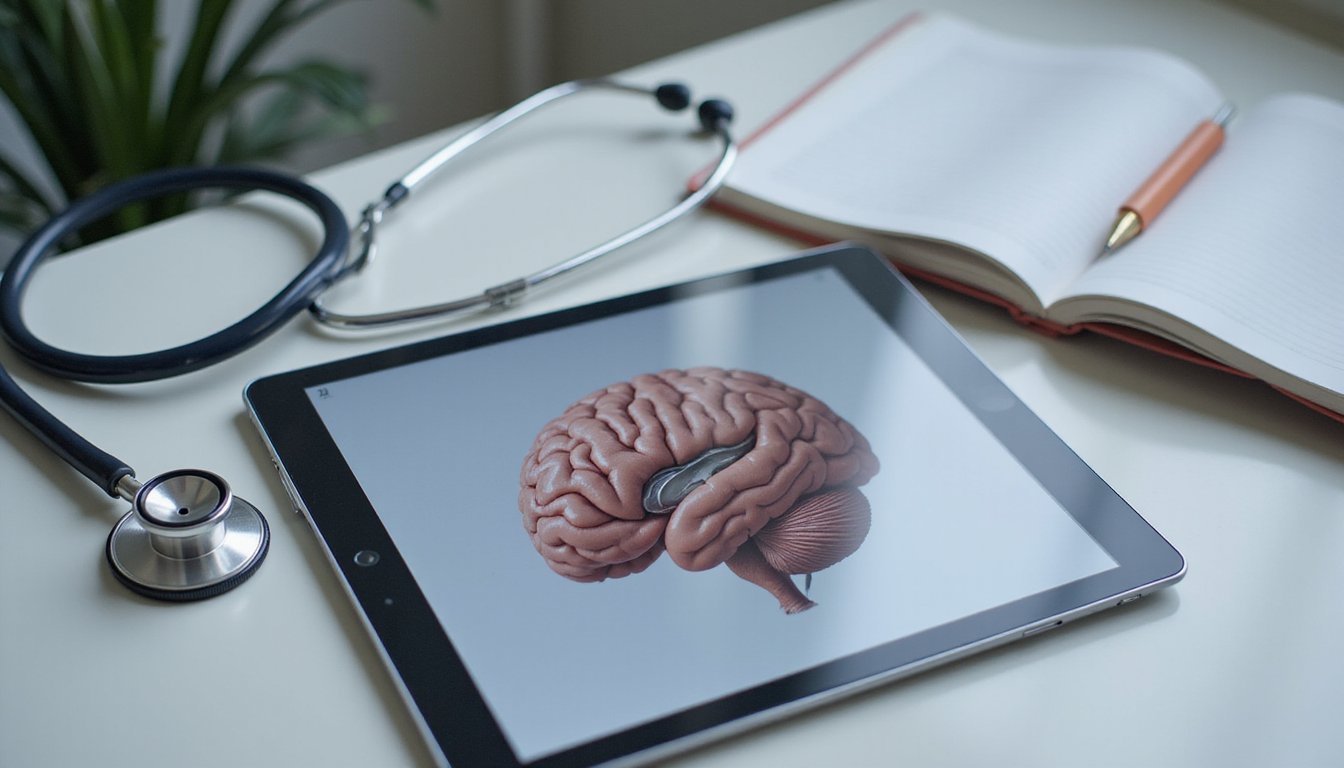Co-existing anxiety and depression arise from multiple interconnected factors affecting your brain and life experiences. Your genetics account for about 40% of your risk, while environmental stressors, childhood experiences, and brain chemistry changes contribute to both conditions. You’ll notice overlapping symptoms like sleep problems, fatigue, and difficulty concentrating that create self-reinforcing cycles. Understanding these complex connections can help you better recognize and address your symptoms.
Neurobiological Mechanisms and Brain Function

The neurobiological mechanisms underlying co-existing anxiety and depression reveal intricate connections between genetic factors, brain structure, and neural function. When you experience these conditions, your brain shows specific changes in key regions like the hippocampus and prefrontal cortex, where neurotransmitter imbalances can lead to neuronal atrophy. Your amygdala becomes more active while your prefrontal cortex’s ability to regulate emotions decreases. This pattern is especially common in patients with anxious major depression, who typically experience more severe symptoms and suicidal thoughts. The presence of oxidative stress can cause significant damage to neuronal DNA, further contributing to the development and progression of these mood disorders. Mainstream treatments like selective serotonin reuptake inhibitors show moderate effectiveness in treating both conditions simultaneously.
Research shows that both disorders share about 40% heritability and common genetic risk factors. Your brain’s plasticity plays a vital role in how you respond to stress, with chronic stress potentially disrupting glutamate systems and reducing dendritic branching. Understanding these mechanisms helps explain why anxiety and depression often occur together, as they affect similar neural circuits and molecular pathways in your brain.
Shared Symptoms and Bridge Factors
When you experience anxiety and depression simultaneously, you’ll notice significant overlap in key symptoms like sleep disruption, fatigue, and concentration difficulties, making it challenging to distinguish between the two conditions. The disorders share bridge factors that reinforce each other, particularly through cognitive distortions and avoidance behaviors that create self-perpetuating cycles. These interconnected symptoms form complex networks where anxiety’s hypervigilance often feeds into depression’s anhedonia, while depressive rumination can heighten anxious thoughts, creating a bidirectional relationship that requires thorough clinical attention. Research shows that patients with anxious depression experience more severe depressive symptoms and face a higher risk of recurrent episodes compared to those with non-anxious depression. Studies indicate that approximately 50% of adults diagnosed with psychiatric disorders have two or more conditions within a 12-month period, highlighting the common nature of these co-occurring conditions.
Overlapping Behavioral Manifestations
Understanding anxiety and depression‘s overlapping behavioral manifestations reveals a complex interplay of shared symptoms and bridge factors that affect approximately 80% of diagnosed cases. You’ll notice distinct behavioral patterns emerge, including social withdrawal, avoidance of activities, and persistent rumination about negative events. These behaviors often create a self-reinforcing cycle where emotional responses become increasingly intense and harder to manage.
You might experience impaired problem-solving abilities and difficulty with decision-making, as both conditions affect executive function. Your tendency to withdraw from social interactions can intensify feelings of isolation, while hypervigilance and automatic negative thoughts about yourself or your future can maintain both anxiety and depressive symptoms. Physical manifestations often include fatigue, sleep disturbances, and reduced interest in previously enjoyable activities. Research indicates that approximately 1 in 6 adults will experience depression during their lifetime, often alongside anxiety symptoms. The presence of chronic pain conditions can significantly worsen both anxiety and depression, with studies showing that about 65% of depressed patients report physical pain symptoms.
Core Connecting Features
Core connecting features between anxiety and depression reveal intricate biological and psychological bridges that help explain their frequent co-occurrence. You’ll find core emotional dysregulation at the heart of both conditions, manifesting through chronic numbness or heightened emotional reactivity. Shared vulnerability factors, including serotonin imbalances and limbic system dysfunction, create a biological foundation for comorbidity.
Your risk increases through overlapping triggers like trauma, chronic stress, and negative life events. These experiences can activate genetic predispositions and alter brain chemistry, particularly in the HPA axis. The relationship between these disorders is further strengthened by common cognitive distortions and maladaptive coping mechanisms. When you experience one condition, neurobiological changes and psychological patterns often create fertile ground for the other to develop.
Symptom Network Relationships
The intricate web of symptoms connecting anxiety and depression creates distinct network patterns that illuminate their complex relationship. Through symptom interactions, you’ll notice how emotional feedback loops reinforce both conditions simultaneously. When you experience one disorder, its manifestations often trigger or intensify symptoms of the other. Research shows that 75% of depressed individuals also experience anxiety disorders, highlighting the frequent overlap of these conditions.
| Symptom Type | Anxiety Impact | Depression Impact | Bridge Effect |
|---|---|---|---|
| Sleep | Racing thoughts | Early waking | Chronic fatigue |
| Cognition | Worry cycles | Poor focus | Mental exhaustion |
| Physical | Muscle tension | Body aches | Pain amplification |
| Behavioral | Social avoidance | Withdrawal | Isolation spiral |
Understanding these relationships helps explain why treating one condition alone often proves insufficient. The interconnected nature of symptoms suggests that targeting bridge factors, like sleep disruption or social withdrawal, may offer more effective intervention points for breaking these self-reinforcing cycles.
Developmental and Early Life Influences
Early environmental stressors you experience during critical developmental periods can greatly shape your vulnerability to co-occurring anxiety and depression. You’ll find that childhood trauma, neglect, or chronic stress disrupts your emotional regulation systems and creates lasting alterations in brain circuitry, particularly in prefrontal-limbic connections. Your early stress response patterns, especially during preadolescence, can establish maladaptive coping mechanisms that increase your risk of developing both conditions by up to five-fold. Recent research has shown that shared risk factors can contribute to the simultaneous development of anxiety and depression in youth.
Early Environmental Risk Factors
Understanding developmental origins of anxiety and depression requires examining critical environmental influences during key neurodevelopmental windows. Your risk for co-occurring conditions greatly increases when early maternal care is compromised or when you’re exposed to prenatal stressors. Research indicates that your BDNF gene variation can significantly influence how early life experiences affect anxiety development. Studies show that epigenetic changes can permanently alter brain function following early trauma. The impact of childhood bullying creates lasting vulnerabilities that increase lifetime depression risk. Socioeconomic disadvantage and urban environments can amplify these vulnerabilities through increased stress exposure.
| Risk Factor | Impact | Critical Window |
|---|---|---|
| Poor Maternal Care | Altered anxiety response | Infancy |
| Prenatal Stress | Changed brain plasticity | Pregnancy |
| Nutritional Deficits | Impaired development | Pregnancy-Early childhood |
| Urban Environment | Chronic stress exposure | Ongoing |
| Social Disadvantage | Heightened vulnerability | Early years |
Your genetic predispositions interact with these environmental factors during critical developmental windows, potentially leading to maladaptive emotional regulation patterns. While early adversity poses considerable risks, protective factors like stable parenting can help buffer these impacts on your mental health trajectory.
Childhood Stress Response Patterns
When children experience prolonged or severe stress during critical developmental periods, their brains and bodies undergo significant adaptations that can persist throughout life. Childhood trauma can disrupt your stress resilience by altering neuroendocrine changes and developmental trajectories, making you more susceptible to anxiety and depression. The negative self-beliefs developed during childhood abuse often persist into adulthood, reinforcing patterns of depression and anxiety. Supportive caregivers can help buffer these adverse effects and promote healthier development. Exposure to toxic stress response during childhood significantly increases long-term health risks, including mental illness.
You’ll notice these early experiences shape your emotional dysregulation patterns and coping strategies. Without proper social support, you’re likely to develop maladaptive attachment styles and trust issues. Your brain’s stress response systems become sensitized, leading to difficulties in identity formation and emotional self-regulation. The impact manifests through both psychological and physiological changes, from altered cortisol rhythms to disrupted neurotransmitter systems. These adaptations can create a foundation for co-occurring anxiety and depression, particularly when early trauma has compromised your ability to process and regulate emotions effectively.
Cognitive-Emotional Processing Patterns

Research into cognitive-emotional processing patterns reveals distinct strategies that either perpetuate or alleviate anxiety and depression symptoms. Your cognitive biases and emotion regulation approaches greatly impact your mental health trajectory. When you engage in maladaptive strategies like self-blame, rumination, or catastrophizing, you’re more likely to experience intensified symptoms of both conditions.
Your ability to process emotions effectively depends on cognitive flexibility and emotional awareness. If you struggle to identify emotions or distinguish between emotional and physical sensations, you’ll find it harder to implement adaptive strategies. While positive reappraisal and acceptance can help counteract negative patterns, your processing speed and cognitive flexibility play vital roles in determining how effectively you can shift between different emotional regulation strategies. These patterns ultimately shape your vulnerability to concurrent anxiety and depression. A study of 1,632 participants demonstrated how cognitive emotion regulation strategies significantly influence both anxiety and depression outcomes.
Environmental and Social Stressors
As environmental and social stressors converge in modern life, they create a complex web of risk factors for co-occurring anxiety and depression. You’re exposed to multiple challenges, from noise pollution and poor housing conditions to limited green spaces and toxic chemicals in your environment. Urban density, high crime rates, and deteriorating air quality can heighten your vulnerability to mental health issues.
Your risk increases further through inadequate social support, gender disparities in safety, and trauma exposure. Workplace stressors, including hostile environments and economic insecurity, compound these effects. Social media pressures, climate change impacts, and seasonal changes add additional layers of stress. Natural disasters can trigger immediate psychological responses, while chronic environmental challenges like limited natural light and poor housing conditions create sustained mental health risks.
Genetic and Hereditary Components

The genetic underpinnings of co-existing anxiety and depression reveal a complex interplay of hereditary factors, with approximately 40% of your risk attributed to genetic inheritance. Your genetic predisposition can influence both conditions through shared biological pathways and overlapping genetic variants.
Studies of twins have consistently shown higher concordance rates in identical twins compared to fraternal twins, confirming strong hereditary influences. If you have family members with these conditions, you’re more likely to develop them due to shared genetic architecture and DNA methylation patterns. Your genes can also affect how you respond to environmental stressors, as certain genetic variants increase your susceptibility to anxiety and depression triggers. This gene-environment interaction helps explain why some people are more vulnerable to developing these co-occurring conditions when faced with life’s challenges.
Frequently Asked Questions
Can Anxiety and Depression Medications Interact With Natural Supplements?
Yes, natural supplements can greatly interact with your anxiety and depression medications. You’ll need to be especially cautious with St. John’s Wort, which can affect medication efficacy and potentially cause dangerous interactions with SSRIs. Sedative supplements like valerian, kava, and ashwagandha may amplify drowsiness when combined with anxiety medications. Even supplements considered low-risk should be discussed with your healthcare provider, as medication interactions can vary between individuals.
How Long Does It Typically Take to Recover From Co-Existing Conditions?
Your recovery timeline from co-existing anxiety and depression varies considerably based on individual factors. While some people may notice improvements within 8-12 weeks of starting treatment, complete recovery often takes 6-12 months or longer. You’ll likely see the best results with combined treatment approaches, including medication, therapy, and lifestyle changes. It’s important to understand that recovery isn’t linear; you may experience periods of improvement followed by temporary setbacks.
Are Certain Careers or Professions More Likely to Trigger Anxiety-Depression Comorbidity?
You’ll find that high stress professions and creative fields are particularly susceptible to anxiety-depression comorbidity. Healthcare workers, legal professionals, and financial traders often experience this due to intense pressure and demanding schedules. Additionally, creative professionals like artists, writers, and entrepreneurs face unique vulnerabilities due to irregular income, isolation, and constant evaluation. The combination of performance pressure, job insecurity, and emotional demands in these careers greatly increases your risk for developing both conditions simultaneously.
Does Living in Urban Versus Rural Areas Affect Anxiety-Depression Occurrence?
Your location considerably impacts your risk of experiencing anxiety and depression. In rural areas, you’re more vulnerable due to rural isolation, limited mental health resources, and reduced access to specialists. While urban environments offer better healthcare access, you’ll face distinct urban stressors like overcrowding and pollution. Research shows rural residents have a 1.57 times higher likelihood of depression, though women in rural settings are particularly affected, showing 20% higher rates than men.
Can Seasonal Changes Worsen Both Anxiety and Depression Simultaneously?
Yes, seasonal changes can greatly worsen both anxiety and depression simultaneously, particularly through seasonal affective disorder (SAD). You’ll notice that weather changes trigger neurochemical shifts, affecting your serotonin and melatonin levels. When days grow shorter, your circadian rhythm becomes disrupted, intensifying both anxious thoughts and depressive symptoms. Your body’s response to reduced sunlight exposure can create a cascade effect, amplifying both conditions through interconnected biological mechanisms.






